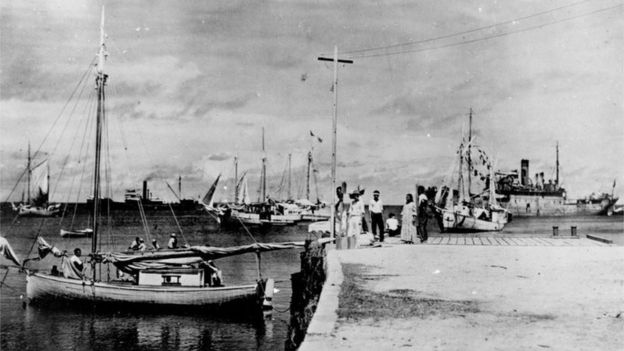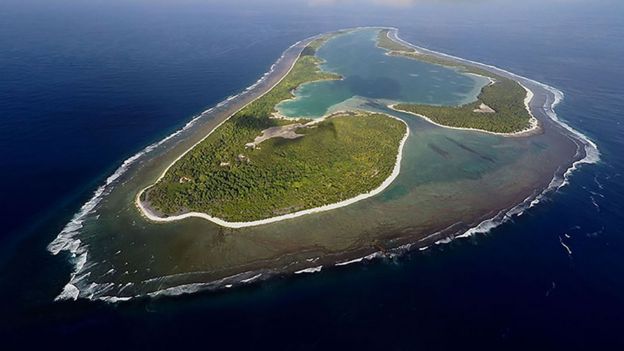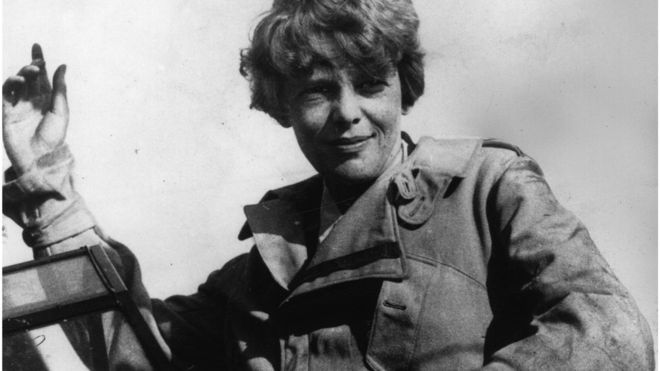Amelia Earhart: Does photo show she died a Japanese prisoner?
BBC
A newly-discovered photo suggests legendary US pilot Amelia Earhart might have died in Japanese custody – and not in a plane crash in the Pacific.
If true, it would solve one of aviation history’s biggest mysteries.
Earhart vanished during a 1937 flight over the Pacific – and her disappearance has been a breeding ground for speculation ever since.
A photograph from the 1930s shows a figure that could be her, taken on the then-Japanese Marshall Islands.
However, at least one prominent expert has poured cold water on the claim, saying he was “astounded” it had taken off.
The new material – presented as evidence for an old theory – is a black-and-white photograph found in the vaults of the US National Archives.
 COURTESY OF LES KINNEY/US NATIONAL ARCHIVES – Earhart, or not? The 1930s picture shows a group of people on the wharf at Jaluit Atoll
COURTESY OF LES KINNEY/US NATIONAL ARCHIVES – Earhart, or not? The 1930s picture shows a group of people on the wharf at Jaluit Atoll
It shows a group of people standing on a dock. The label on the photograph says it was taken on Jaluit Atoll in the Marshall Islands, presumably by a US spy.
The link might seem thin, though, to the legendary pilot who five years before her disappearance had risen to fame as the first woman to fly solo across the Atlantic.
The claim is that one seated person with her back to the camera could be Earhart, while another figure on the far left in the photo is said to be Fred Noonan, her navigator on that last flight.
On the very right of the picture is a blurry section which, it is claimed, shows Earhart’s plane.
 COURTESY OF LES KINNEY/US NATIONAL ARCHIVES – These magnified details of the new picture are alleged to show (from left), navigator Fred Noonan, Earhart herself, and their plane
COURTESY OF LES KINNEY/US NATIONAL ARCHIVES – These magnified details of the new picture are alleged to show (from left), navigator Fred Noonan, Earhart herself, and their plane
Ric Gillespie, author of Finding Amelia and executive director of The International Group for Historic Aircraft Recovery (TIGHAR), is certainly unconvinced.
He told the BBC: “This photograph has people convinced. I’m astounded by this. I mean, my God! Look at this photograph… Let’s use our heads for a moment. It’s undated. They think it’s from 1937. Okay. If it’s from July 1, 1937 then it can’t be Amelia, because she hadn’t taken off yet.
“If it’s from 1935 or 1938 it can’t be her…. This photograph has to have been taken within a very narrow window – within a couple of days of when she disappeared.”
He notes that the photograph came from an Office of Naval Intelligence file, saying it was “very natural” the US would want a picture of this Japanese naval asset.
“And what does the photo say that it shows? … Jaluit Atoll – Jaluit Island. It doesn’t say ‘Amelia Earhart in Japanese custody’!
“If this is a picture of Amelia Earhart in Japanese custody, where are the Japanese? There are no soldiers in this picture. Nobody in uniform,” he observes.
 AURIE RUBIN – Ric Gillespie, author of Finding Amelia, does not believe the picture shows Earhart and her navigator
AURIE RUBIN – Ric Gillespie, author of Finding Amelia, does not believe the picture shows Earhart and her navigator
The photograph was released by the US-based History channel ahead of a documentary to run this weekend. If the goal was to drum up attention – and hence audience numbers – it appears to have paid off.
A preview of the programme has two experts backing up the claim by looking at the torso measurements of the woman alleged to be Amelia Earhart in the photo, and teeth and hairline of the figure claimed to be Fred Noonan.
Mystery hunters and stories
A far stretch? After all, the heroine has her back to the camera and it’s debatable how much of a hairline let alone teeth can really be made out reliably on a faded photograph from the 1930s.
Mr Gillespie says it doesn’t match other known pictures of the famous aviator.
“The person who they say is Amelia Earhart might be a white woman. But her hair is way too long to be Amelia’s. We have many pictures of Earhart taken the day before she took off, and her hair’s a lot shorter than that.”
 GETTY IMAGES – The fate of Amelia Earhart and Fred Noonan has long fascinated historians
GETTY IMAGES – The fate of Amelia Earhart and Fred Noonan has long fascinated historians
He adds that the man identified as Fred Noonan does not, in his view, resemble the navigator. Further, his shirt is the wrong colour.
“The man is dressed in white. Noonan always wore dark shirts and dark slacks. Amelia didn’t have a shirt like that with her on the trip either. So the Japanese have apparently given them new clothes.
“Everything about this is wrong,” he concludes. “I’m astounded.”
Did she crash on land?
Scepticism aside, the alleged scoop feeds into one of the existing theories about what happened to Earhart and her navigator.
She disappeared during her attempt to fly around the globe, trying to reach Howland Island in the Pacific for refuelling.

The official explanation is that she didn’t find the island, lost communication and ran out of fuel, only to crash into the ocean.
While that’s a largely accepted version of events, there is no evidence – as in debris – to back it up.
The two other prominent theories are that Earhart crash-landed on or near the then-Japanese Marshall Islands, or that she made it to Nikumaroro island near Kiribati and died a castaway there.
There is no conclusive evidence for either of these theories – but that hasn’t stopped amateur and professional historians from digging into them.
 TIGHAR – Nikumaroro island was uninhabited at the time Earhart would have landed there
TIGHAR – Nikumaroro island was uninhabited at the time Earhart would have landed there
Parts of a skeleton found on Nikumaroro in 1940 were initially thought to have been hers, but doctors at the time decided they belonged to a male body.
Mr Gillespie, who backs the Nikumaroro theory, has led 11 expeditions in the South Pacific to research Earhart’s fate. He points out that the island was uninhabited at the time when Earhart would have landed there.
He and his team have recovered artefacts which they say strongly suggest the presence of an American woman from the right era – including a makeup box from the 1930s, a popular US women’s moisturiser, and a jacket zipper.
 TIGHAR – Ric Gillespie and his team excavating on Nikumaroro, where they believe Earhart’s plane came down
TIGHAR – Ric Gillespie and his team excavating on Nikumaroro, where they believe Earhart’s plane came down
 TIGHAR – The team found a bone-handled jack knife that matches one mentioned in Earhart’s inventory
TIGHAR – The team found a bone-handled jack knife that matches one mentioned in Earhart’s inventory
Mr Gillespie also cites the timing and location of radio distress calls sent by Earhart after her plane came down. He says the calls were sent “night after night” – which would suggest the plane was on land, not in the water – because if the radios got wet, they wouldn’t work.
“After six nights the radio signals stopped,” he told the BBC. “We now think that’s because the airplane was landed on the reef round the island, which is flat, smooth – dries at low tide… But the tide does come in and go out, and … by the sixth night [he believes] the aeroplane was washed into the ocean by the tides.
“So when the planes from the battleship flew over the island a week later, no plane was visible.”
The rest of the search took place in open ocean, and found nothing. The would-be rescuers concluded that Earhart and Noonan had sunk without a trace.
A mystery still unsolved
The conclusion drawn by the History documentary, based on the new Marshall Islands picture, is that Earhart was taken by the Japanese, later interned and eventually died a prisoner of war.
The Marshall Islands went from German to Japanese hands during World War One, and ahead of the 1941 attack on Pearl Harbor became an important military post for Tokyo.
The Japanese archives have no records of Earhart as a prisoner – but with many documents from these archives known to have been lost, this does not necessarily prove the story wrong.
At the same time, the discovery of a single photograph that may or may not show the two lost pilots is likely to add to the mystery rather than solve it.
